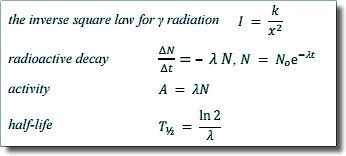Solutions for
Radioactivity: Carbon Dating
Q2.
The age of an ancient boat may be determined by comparing the radioactive decay of from living wood with that of wood taken from the ancient boat.
A sample of 3.00 × l023 atoms of carbon is removed for investigation from a block of living wood. In living wood one in 1012 of the carbon atoms is of the radioactive isotope , which has a decay constant of 3.84 × 10–12 s–1.
(a) What is meant by the decay constant?
The decay constant λ is the probability of decay occuring in a given time period.
or
The decay constant λ is the fraction of nuclei decaying per second
or
The rate of radioactive decay of a nuclide is proportional to the number of nuclei of that nuclide in a sample and the nuclear decay constant λ is the constant of proportionality within that relationship.
(1 mark)
(b) Calculate the half-life of the wood in years, giving your answer to an appropriate number of significant figures.
1 year = 3.15 × 107 s

Thalf = ln 2/λ
Thalf= ln 2/ 3.84 × 10–12 = 1.805 x 1011s
Thalf= 1.805 x 1011/(3.15 × 107) years
Thalf= 5730 years
(3 marks)
(c) Show that the rate of decay of the atoms in the living wood sample is 1.15 Bq.
N = 3.00 × l023/1012 = 3.00 × l011
A = λN = 3.84 × 10–12 x 3.00 × l011 = 1.15 Q.E.D.
(2 marks)
(d) A sample of 3.00 × 1023 atoms of carbon is removed from a piece of wood taken from the ancient boat.
The rate of decay due to the atoms in this sample is 0.65 Bq.
Calculate the age of the ancient boat in years.
A = Aoe-λt
0.65 = 1.15 e-λt
Taking logs
ln (0.65/1.15) = -λt
-0.571 = -3.84 × 10–12 x t
t = 1.487 x 1011 seconds
t = 1.487 x 1011 / (3.15 × 107) years
t = 4721 years
The wood sample is 4720 years old 
(3 marks)
(e) Give two reasons why it is difficult to obtain a reliable age of the ancient boat from the carbon dating described.
 The boat may have been made with the wood some time after the tree was cut down.
The boat may have been made with the wood some time after the tree was cut down.
 The background activity is high compared to the observed count rates
The background activity is high compared to the observed count rates
 The count rates are low or sample size/mass is small or there is statistical variation in the recorded results.
The count rates are low or sample size/mass is small or there is statistical variation in the recorded results.
 There is a possible contamination uncertainty in the ratio of carbon-14 in carbon thousands of years ago.
There is a possible contamination uncertainty in the ratio of carbon-14 in carbon thousands of years ago.
Any two 

(2 marks)
(Total 11 marks)


